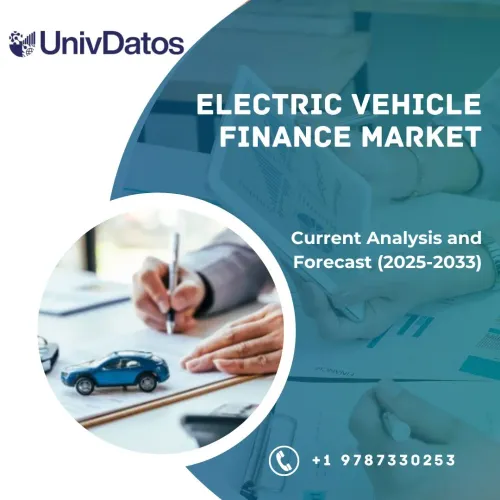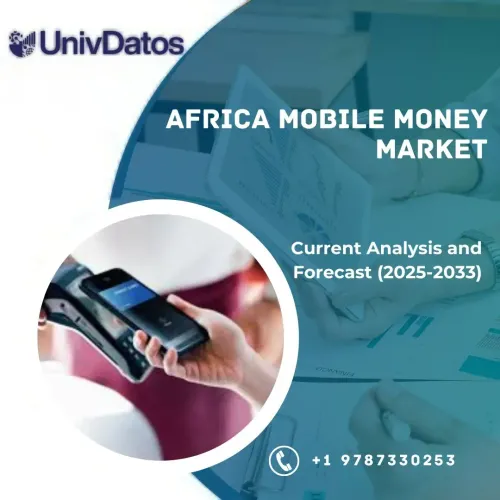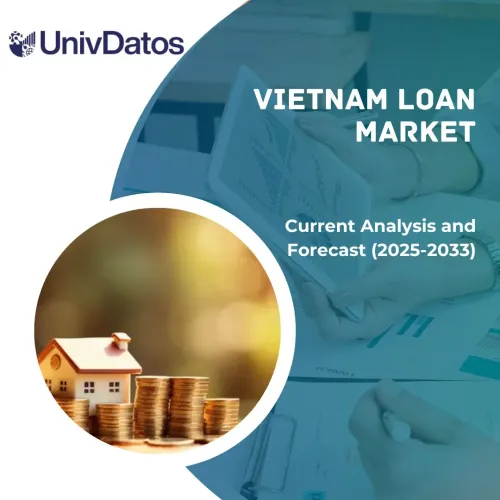- Home
- About Us
- Industry
- Services
- Reading
- Contact Us
Vietnam Loan Market: Current Analysis and Forecast (2025-2033)
Emphasis on Loan Type (Secured Loan, Unsecured Loan); Provider Type (Bank, Non-Banking Financial Companies (NBFCs), Others); Interest Rate Structure (Fixed Interest Rate Loans, Floating Interest Rate Loans); End-User (Individual Consumers, Corporates, Small & Medium Enterprises (SMEs)); Tenure Period (Less Than 5 Years, 5-10 Years, 11-20 Years, More than 20 Years); and Region/Provinces
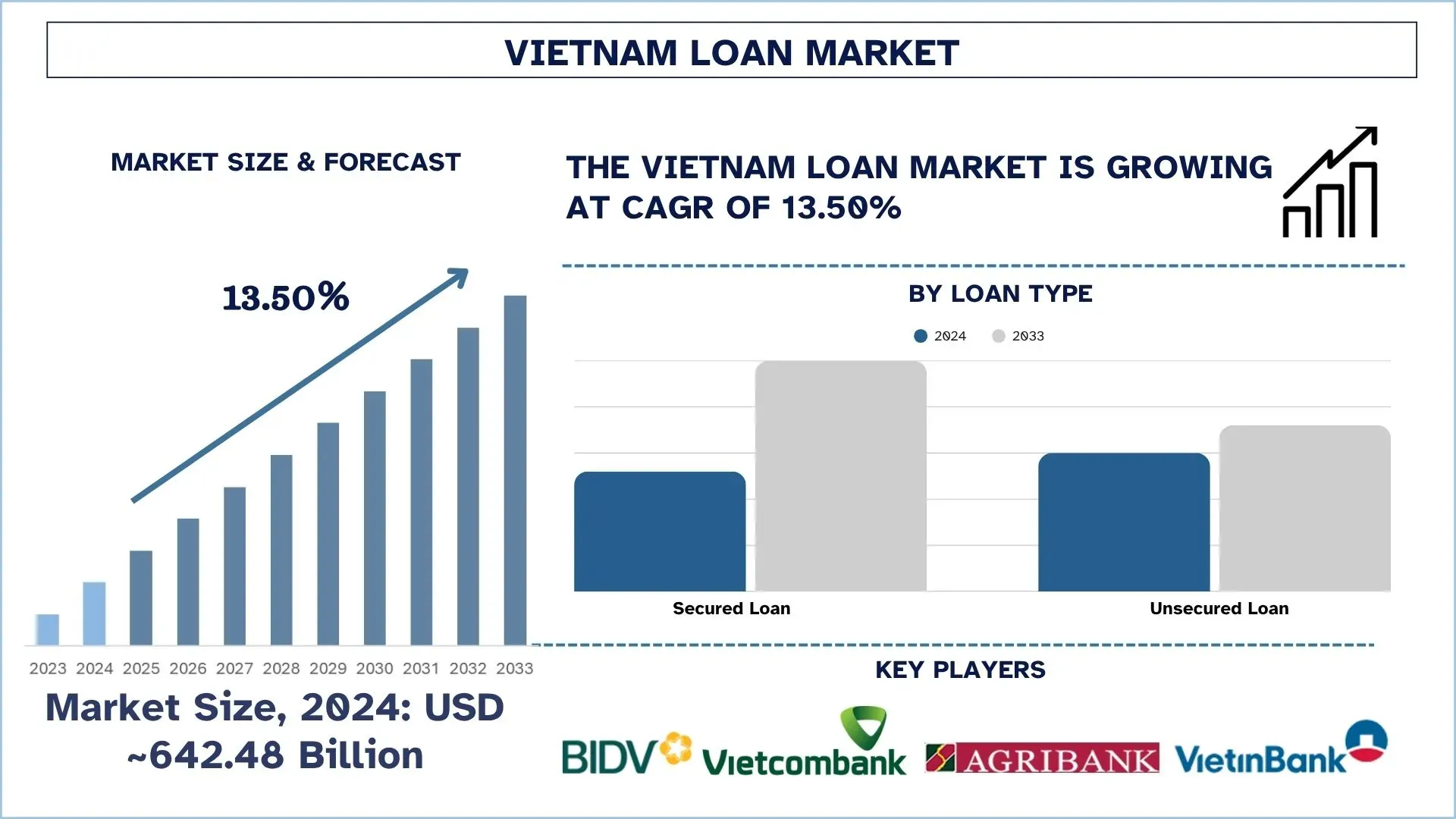
Vietnam Loan Market Size & Forecast
The Vietnam Loan Market was valued at USD ~642.48 Billion in 2024 and is expected to grow to a strong CAGR of around 13.50% during the forecast period (2025-2033F), owing to the rapid digital transformation in banking, coupled with government initiatives for financial inclusion.
Vietnam Loan Market Analysis
A loan is a borrowed amount funded by financial institutions or lenders to individuals, corporations, or organizations under defined conditions, typically including terms of interest charges and repayment terms. It allows borrowing money for purchasing a house, education, business growth, and other expenses.
Vietnamese companies are leveraging digital lending platforms, artificial intelligence-driven credit scoring, and mobile-based loan applications to expand their reach and accelerate the approval process. Moreover, NBFCs and banks are launching special products for SMEs as well as personal loans with flexible tenures and competitive interest rates. Furthermore, the embedded finance options are expanding through partnerships with e-commerce and fintech companies, and lenders are turning to blockchain technology to ensure the transparency and compliance of their business operations. Moreover, the issuance of green financing products is incorporated into ESG strategies and allows financial institutions to take advantage of an increasing interest in climate-conscious credit services.
On August 28, 2024, Vietnam’s central bank announced changes to its sustainable banking framework in a bid to boost access to green credit for companies, in a fast-growing Asian economy that is seeking to wean itself off coal and ramp up renewable energy production.
Vietnam Loan Market Trends
This section discusses the key market trends that are influencing the various segments of the Vietnam Loan market, as found by our team of research experts.
Rise of Peer-to-Peer (P2P) Lending
In Vietnam, the growth of Peer-to-Peer (P2P) lending business is due to the growth in internet penetration, use of digital payment, and the need to gain access to rapid, unsecured credit at short notice. P2P does not promise the same as ordinary banks because they provide quicker approvals and even competitive rates, a feature that is quite appealing to technically oriented millennials and SMEs. Formalizing P2P lending by regulation is increasing credibility and raising investor confidence. The trend augments financial inclusion to a significant degree, making P2P a significant driver of expanded growth in Vietnam concerning the digital lending environment.
On May 2, 2025, Vietnam’s government approved a two-year pilot programme to test peer-to-peer (P2P) lending, credit scoring, and open API-based data sharing. Outlined under Decree 94 issued on 29 April, the initiative introduces a regulatory sandbox for fintech innovations in the banking sector, set to begin on 1 July.Top of Form
Vietnam Loan Industry Segmentation
This section provides an analysis of the key trends in each segment of the Vietnam Loan market report, along with forecasts at the regional and provincial levels for 2025-2033.
The Secured loan Market held a dominant market share in 2024.
Based on the loan type, the market is segmented into secured loans and unsecured loans. The secured loan segment held a dominant share of the loan market in 2024. The demand for housing and the rapid development of urban infrastructure have led to secured loans in Vietnam becoming one of their primary sources of growth. Furthermore, the loans reduce credit-related risks to the lenders, and this fact encourages the banks to offer favorable interest rates and terms. This brings in stability in the revenue base, which will encourage more players to come to the market. To illustrate, on February 14, 2025, Asia Commercial Bank (ACB) introduced the First Home loan package, specifically designed for younger buyers looking to get on the property ladder. The programme offers loan terms of up to 30 years, with an attractive interest rate starting from 5.5% per year and a fixed rate for the first five years. This initiative aims to help young customers with stable incomes access capital more easily to purchase their first home.
The small & medium enterprises (SMEs) segment is expected to grow with the highest CAGR during the forecast period (2025-2033).
Based on the end-user, the market is segmented into individual consumers, corporates, and small & medium enterprises (SMEs). Among these, the small & medium enterprises (SMEs) segment is expected to grow with the highest CAGR during the forecast period (2025-2033) due to the increasing demand for working capital and expansion loans. Due to the high contribution of SMEs to the Vietnamese economy, customized loan products for this category stimulate credit use. SME loan lending institutions also benefit from increased market share, which provides a competitive advantage. On April 26, 2024, the Government of Vietnam issued Decree 45/2024/NĐ-CP, which amends Decree 39/2019/NĐ-CP of May 10, 2019, on the organization and operation of the country’s Small and Medium-Sized Enterprise Development Fund (SME Fund). The aim of the new decree is to generate broader economic benefits under the SME Fund.
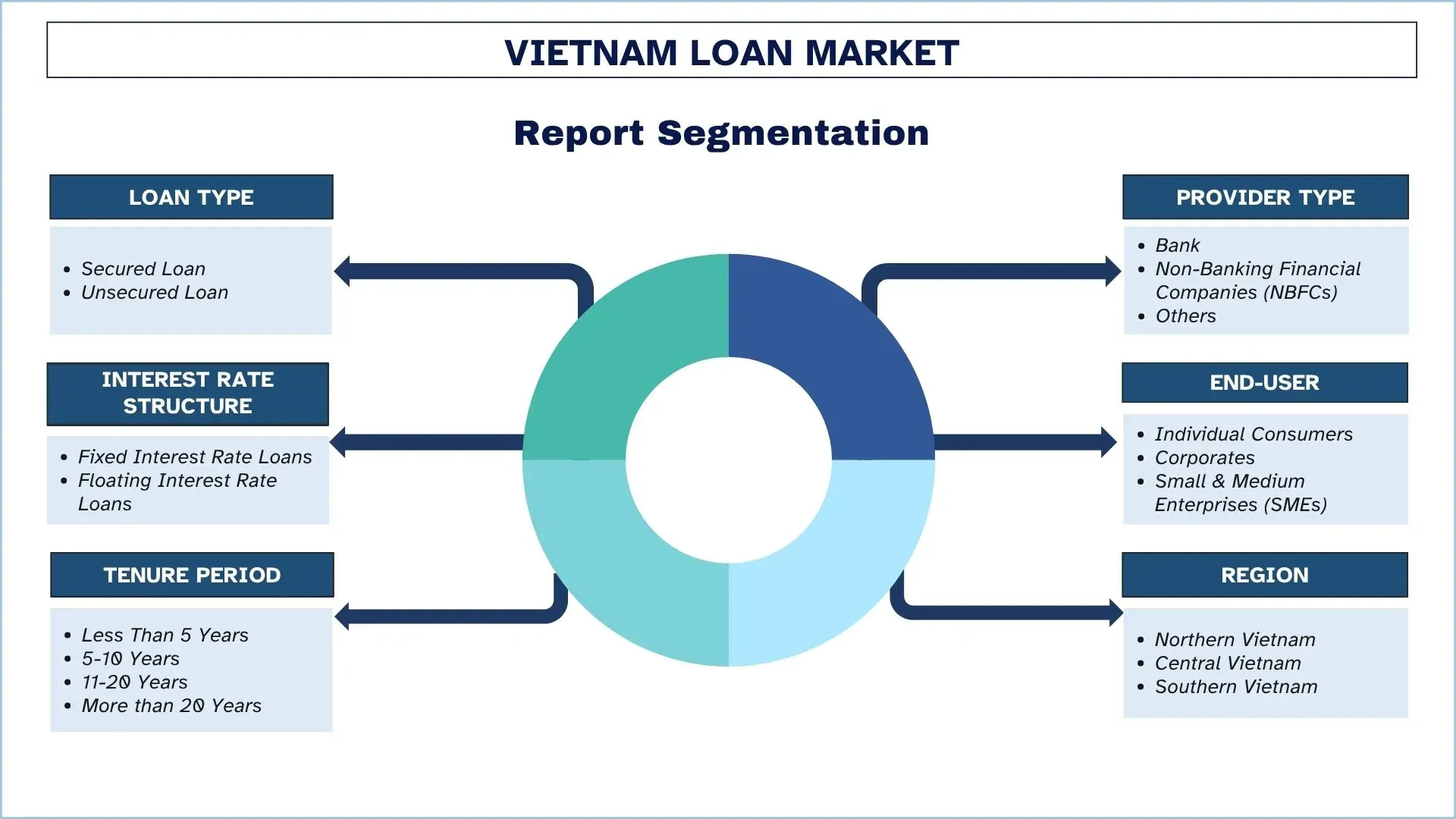
Southern Vietnam is expected to grow with a significant CAGR during the forecast period (2025-2033).
In South Vietnam, the market is led by Ho Chi Minh City as the financial powerhouse, located in a rapidly urbanizing environment surrounded by a vibrant commercial economy and a high level of consumer spending. Due to its vibrant retail-based and export-based economy, the area is a hotspot for unsecured personal loans, short-term credit, and SME financing. The adoption of digital lending is especially strong in this area because technologically sophisticated consumers and companies are moving to mobile-first loan products. The lenders that target this market experience faster loan distribution and an increasing market base of young borrowers.
On May 9, 2025, Vietnam planned to secure a 500 trillion dong (approximately USD 20 billion) loan package involving 21 banks to finance infrastructure and technology projects aimed at boosting economic growth—a financing move that is historically atypical for the country. The Southeast Asian nation is targeting economic growth of around 8% this year, up from 7.1% in 2024, the highest in two years, despite potential damage from the trade war triggered by the U.S., its biggest export market.

Vietnam Loan Industry Competitive Landscape
The Vietnam Loan market is competitive, with several global and international market players. The key players are adopting different growth strategies to enhance their market presence, such as partnerships, agreements, collaborations, new product launches, geographical expansions, and mergers and acquisitions.
Top Vietnam Loan Companies
Some of the major players in the market are Joint Stock Commercial Bank for Investment and Development of Vietnam (BIDV), Joint Stock Commercial Bank for Foreign Trade of Vietnam (Vietcombank), Vietnam Bank for Agriculture and Rural Development, Vietnam Joint Stock Commercial Bank for Industry and Trade (VietinBank Group), An Binh Commercial Joint Stock Bank (ABBANK), Asia Commercial Joint Stock Bank, Bac A Commercial Joint Stock Bank (Bac A Bank), Bao Viet Joint Stock Commercial Bank (BAOVIET Bank), Global Petro Commercial Joint Stock Bank (GPBANK), Vietnam Public Joint Stock Commercial Bank (PVcomBank).
Recent Developments in the Vietnam Loan Market
On July 31, 2024, the Joint Stock Commercial Bank for Investment and Development of Vietnam (BIDV) and the French Agency for Development in Vietnam (AFD Vietnam) signed a €50 million (USD 58.83 million) climate credit line agreement. This new funding will support projects focused on climate change mitigation, adaptation, and sustainable development.
On 12 June 2024, the Asian Development Bank (ADB) and Lien Viet Post Joint Stock Commercial Bank (LPBank) signed a financing package of up to USD 80 million to expand access to finance for a women-owned small and medium-sized enterprises (WSMEs) project in Viet Nam.
In June 2022, DFDL was honored by LegalOne for its key role in a historic deal to secure cross-border financing for a solar energy farm in Vietnam – the country’s first-ever “Green loan.” Members of DFDL’s Energy, Mining and Infrastructure practice acted as legal counsel in Vietnam for B.Grimm Power Plc, which secured a USD 186 million loan from the Asian Development Bank (“ADB”) and other key lenders, and its Vietnamese subsidiary Phu Yen TTP Joint Stock Company.
Vietnam Loan Market Report Coverage
Report Attribute | Details |
Base year | 2024 |
Forecast period | 2025-2033 |
Growth momentum | Accelerate at a CAGR of 13.50% |
Market size 2024 | USD ~642.48 Billion |
Regional analysis | Northern Vietnam, Central Vietnam, and Southern Vietnam. |
Major contributing region | Southern Vietnam is expected to grow at the highest CAGR during the forecasted period. |
Companies profiled | Joint Stock Commercial Bank for Investment and Development of Vietnam (BIDV), Joint Stock Commercial Bank for Foreign Trade of Vietnam (Vietcombank), Vietnam Bank for Agriculture and Rural Development, Vietnam Joint Stock Commercial Bank for Industry and Trade (VietinBank Group), An Binh Commercial Joint Stock Bank (ABBANK), Asia Commercial Joint Stock Bank, Bac A Commercial Joint Stock Bank (Bac A Bank), Bao Viet Joint Stock Commercial Bank (BAOVIET Bank), Global Petro Commercial Joint Stock Bank (GPBANK), Vietnam Public Joint Stock Commercial Bank (PVcomBank) |
Report Scope | Market Trends, Drivers, and Restraints; Revenue Estimation and Forecast; Segmentation Analysis; Demand and Supply Side Analysis; Competitive Landscape; Company Profiling |
Segments Covered | By Loan Type, By Provider Type, By Interest Rate Structure, By End-User, By Tenure Period, By Region/Province |
Reasons to Buy the Vietnam Loan Market Report:
The study includes market sizing and forecasting analysis confirmed by authenticated key industry experts.
The report briefly reviews overall industry performance at a glance.
The report covers an in-depth analysis of prominent industry peers, primarily focusing on key business financials, type portfolios, expansion strategies, and recent developments.
Detailed examination of drivers, restraints, key trends, and opportunities prevailing in the industry.
The study comprehensively covers the market across different segments.
Deep dive regional-level analysis of the industry.
Customization Options:
The Vietnam Loan Market can further be customized as per the requirements or any other market segment. Besides this, UnivDatos understands that you may have your own business needs; hence, feel free to contact us to get a report that completely suits your requirements.
Table of Content
Research Methodology for the Vietnam Loan Market Analysis (2023-2033)
We analyzed the historical market, estimated the current market, and forecasted the future market of the Vietnam Loan market to assess its application in major regions in Vietnam. We conducted exhaustive secondary research to gather historical market data and estimate the current market size. To validate these insights, we carefully reviewed numerous findings and assumptions. Additionally, we conducted in-depth primary interviews with industry experts across the Loan value chain. After validating market figures through these interviews, we used both top-down and bottom-up approaches to forecast the overall market size. We then employed market breakdown and data triangulation methods to estimate and analyze the market size of industry segments and sub-segments.
Market Engineering
We employed the data triangulation technique to finalize the overall market estimation and derive precise statistical numbers for each segment and sub-segment of the Vietnam Loan market. We split the data into several segments and sub-segments by analyzing various parameters and trends, including loan type, provider type, interest rate structure, end-user, tenure period, and regions within the Vietnam Loan market.
The Main Objective of the Vietnam Loan Market Study
The study identifies current and future trends in the Vietnam Loan market, providing strategic insights for investors. It highlights regional market attractiveness, enabling industry participants to tap into untapped markets and gain a first-mover advantage. Other quantitative goals of the studies include:
Market Size Analysis: Assess the current market size and forecast the market size of the Vietnam Loan market and its segments in terms of value (USD).
Loan Market Segmentation: Segments in the study include areas of loan type, provider type, interest rate structure, end-user, tenure period, and regions.
Regulatory Framework & Value Chain Analysis: Examine the regulatory framework, value chain, customer behavior, and competitive landscape of the Loan industry.
Regional Analysis: Conduct a detailed regional analysis for key areas such as Northern Vietnam, Central Vietnam, and Southern Vietnam.
Company Profiles & Growth Strategies: Company profiles of the Loan market and the growth strategies adopted by the market players to sustain in the fast-growing market.
Frequently Asked Questions FAQs
Q1: What is the Vietnam Loan market’s current market size and growth potential?
The Vietnam Loan market was valued at USD ~642.48 billion in 2024 and is expected to grow at a CAGR of 13.50% during the forecast period (2025-2033). Strong economic growth, rising consumer credit demand, and increasing SME financing are key factors driving this expansion.
Q2: Which segment has the largest share of the Vietnam Loan market by Loan Type?
Secured loan holds the largest market share due to the high demand for mortgages, auto loans, and business loans. Their lower risk and competitive interest rates make them a preferred choice for banks and borrowers alike.
Q3: What are the driving factors for the growth of the Vietnam Loan market?
Key growth drivers include rising disposable income, strong housing demand, digital banking adoption, and government policies promoting financial inclusion. Additionally, increasing credit needs from SMEs and consumer lending further boost market growth.
Q4: What are the emerging technologies and trends in the Vietnam Loan market?
Major trends include digital lending platforms, AI-based credit scoring, peer-to-peer (P2P) lending, and blockchain for loan processing. Additionally, green financing products and embedded finance in e-commerce are gaining momentum.
Q5: What are the key challenges in the Vietnam Loan market?
Challenges include high non-performing loan (NPL) ratios, limited credit history for rural borrowers, regulatory uncertainties for fintech, and cybersecurity risks. Intense competition among banks and NBFCs also pressures profit margins.
Q6: Which region dominates the Vietnam Loan market?
Northern Vietnam, led by Hanoi, dominates the market due to its dense population, strong industrial base, and robust financial infrastructure. However, Southern Vietnam is emerging as the fastest-growing region, driven by Ho Chi Minh City’s booming economy and digital lending adoption.
Q7: Who are the key players in the Vietnam Loan market?
Some of the leading companies in the Vietnam Loan Industry include:
• Joint Stock Commercial Bank for Investment and Development of Vietnam (BIDV)
• Joint Stock Commercial Bank for Foreign Trade of Vietnam (Vietcombank)
• Vietnam Bank for Agriculture and Rural Development
• Vietnam Joint Stock Commercial Bank for Industry and Trade (VietinBank Group)
• An Binh Commercial Joint Stock Bank (ABBANK)
• Asia Commercial Joint Stock Bank
• Bac A Commercial Joint Stock Bank (Bac A Bank)
• Bao Viet Joint Stock Commercial Bank (BAOVIET Bank)
• Global Petro Commercial Joint Stock Bank (GPBANK)
• Vietnam Public Joint Stock Commercial Bank (PVcomBank)
Q8: How are financial institutions innovating to drive growth in the Vietnam Loan Market?
Lenders are adopting AI-powered risk assessment, mobile-first loan applications, and partnerships with fintech firms for embedded finance. They are also offering customized SME loan products and expanding digital credit to underserved rural areas.
Q9: What is the future outlook for the Vietnam Loan Market?
The Vietnam Loan Market is expected to see significant growth, driven by digital lending innovations, fintech collaborations, and rising demand for SME financing and consumer credit. The government’s infrastructure investments and focus on financial inclusion will further boost loan penetration. Additionally, green financing and sustainable lending practices will open new opportunities for banks and NBFCs.
Related Reports
Customers who bought this item also bought

